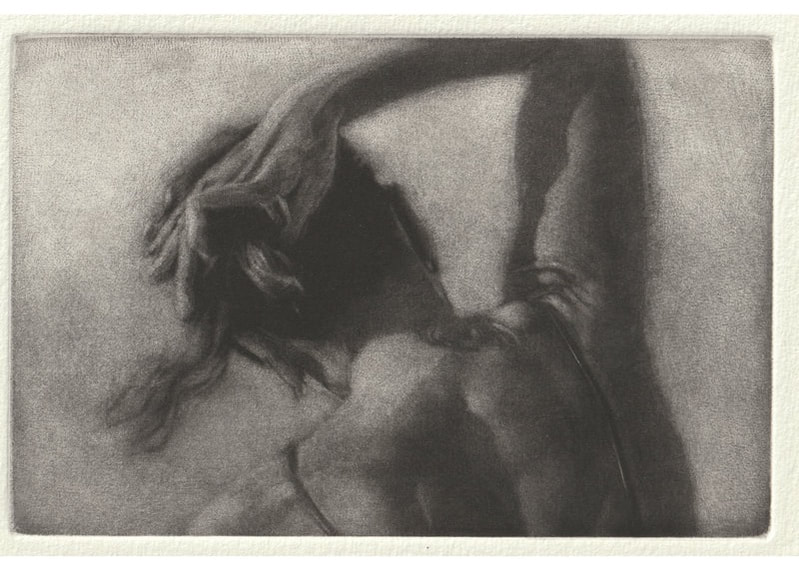|
What are the most common mistakes ( and how to correct them)? The most common mistake while working on a plate is too much scraping: either an area has become lighter than intended, or perhaps one has scraped an area that was supposed to be black. If the area is small, the plate can be carefully rocked again with a small rocker and it won't be too difficult to make some minor changes. When this is not possible, another solution is to tap a drypoint needle and make some dots that will blend in with the exisiting marks: this will make the area darker, once printed. Another common mistake is to wipe the plate too vigorously while printing. It is important to understand that although mezzotint is an intaglio technique, weirdly a mezzotint plate is similar to a relief matrix: the lightest parts have been scraped so are a little lower than the dark parts. For this reason wiping should be done really gently or the dark grays will fade. I use a dirty tarlatan in circular movements for the first step lightly pushing the ink in, then as the image becomes visible I wipe with a cleaner tarlatan in swiping movements, and finally I do quite a lot of wiping with the palm of my hand, concentrating on the light areas and wiping in the direction of the dark ones. How much do you plan before starting a work on a new plate ? A mezzotint requires a time investment so it is good to be confident about the strength of the composition. Before embarking on a new print, once I have found an interesting subject, I think about the concept of Notan, a Japanese word that defines the balance between dark and lights: I generally work from a drawing or a photographic reference, carefully considering the tonal distribution. These are some of the questions I ask myself before the start: Are there geometrical shapes I can enhance? What is going on on the diagonals ? How and where do I place some points of interest ? Which edges will I leave soft and which should be hard ? Is there an area that I want almost white ? Now, a mezzotint plate is like a ticking bomb: one can’t pull a lof of proofs because they might indent the number of prints available for the edition. I only proof the plate when I think I am very close to finishing. The first print is generally the result of the decisions taken during the planning fase, but it won't be exactly as expected. At this point it is important to look at the first proof without "preconceptions". I always try to give myself a little time before I rush to do more work on the plate: I leave it and look at it again the next day. Does the proof suggest a different path ? I am always open to alter my original idea. What other printmaking techniques can you combine with mezzotint ? A rocker, used as a drypoint tool, can make interesting marks on etchings, drypoints or aquatints. I personally haven’t tried but I see fellow printmakers using a burin, hard-ground or soft-ground etching to include some line work before rocking the plate. Right now I am experimenting with Chine Collè and I think that too could be interesting, particularly as a way of introducing some flat, intense colour or altering the tone of the paper. I don’t do multiple-plate coloured prints or ink the plate à la poupée because I don’t feel the need for it. I find that black and white is very powerful and I still haven't found a good reason to give that up. What, aside from the intensity of black and a the gradation of shadows are the generic “pros” and “cons” of mezzotint ? I will start with what mezzo can’t do: it is not a dynamic technique: it doesn’t allow you to draw on the plate with a sweeping, vigorous, idiosyncratic mark. If you look at a square centimeter of a Rembrandt or a Goya etching, you immediately recognise the artist by the peculiarity of the markmaking. This doesn’t really happen in mezzotint: the focus is on the image and how it is filtered through the artist’s vision. There’s also of course an issue with the size of the work, which is limited compared to other intaglio techniques. What is unique to mezzo is its pure tonal nature, which I find incredible for creating a pictorial space, an infinite space into the confined edges of a plate. Also mezzo has a vast range of grays and the chance of controlling edges, compared with another tonal technique such as acquatint, for example.
1 Comment
Marcie
4/5/2024 08:26:55 pm
Dear Ilaria, I find your blog fascinating - you write beautifully. The articles are both poetic and very informative. Thank you for sharing your knowledge so generously.
Reply
Leave a Reply. |
Check the list below to see posts on these subjects.Categories
All
AuthorIlaria Rosselli Del Turco is an Italian painter living in London. |



 RSS Feed
RSS Feed